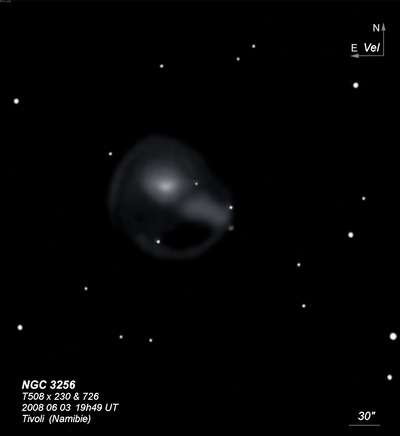
NGC 3256 is a member of the Hydra-Centaurus Supercluster and possible outlying member of the Antlia Cluster (9 degrees north). This cluster was first catalogued as Klemola 12. On photographs NGC 3256 is a chaotic system that appears to be undergoing a spectacular merger with long tidal tails. This starburst galaxy is a superluminous infrared source with X-ray emission.
John Herschel discovered NGC 3256 = h3254 on 15 Mar 1836 and recorded "B, R, gmbM, 25"." His position (measured on two sweeps) matches ESO 263-038. Joseph Turner observed it on 24 Feb 1879 with the 48" Melbourne Telescope and noted "it is considerably elongated, the densest section being towards the north-following extremlty, the faint section extending in the south-preceding direction."
300/350mm - 13.1" (2/18/04 - Costa Rica): this disturbed galaxy appeared as a moderately bright and large oval, extended 3:2 NW-SE with dimensions 1.6'x1.2'. It contained a fairly bright 1' round core embedded in a very faint halo. NGC 3256 is the furthest north and the brightest in a group of Vela galaxies stretching south to NGC 3261, located 46' to the SSE.
600/800mm - 25" (4/1/19 - OzSky): at 244x; bright, very large, oval 4:3 NW-SE, ~1.6'x1.2', pretty sharply concentrated with a very bright relatively large core that appears off-center. The halo is irregular in brightness. The tidal plumes extending east from the north end and stretching west were not seen in dewy conditions.
NGC 3256C, a highly disrupted galaxy (interacting with NGC 3256) situated 14' ENE, appeared fairly faint, roundish, ~35"-40" diameter. Fairly low but uneven surface brightness, weak concentration. Situated 4' E of mag 6.7 HD 90898. The galaxy is just east of semi-circular chain of stars on the east side of HD 90898. The chain includes three double stars as well as a triple!
Notes by Steve Gottlieb